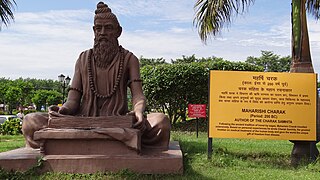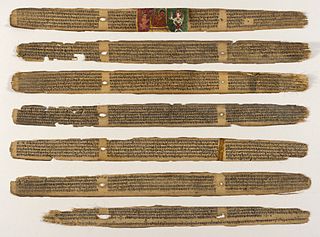
Ophthalmology is a surgical subspecialty within medicine that deals with the diagnosis and treatment of eye disorders.

A cataract is a cloudy area in the lens of the eye that leads to a decrease in vision. Cataracts often develop slowly and can affect one or both eyes. Symptoms may include faded colours, blurry or double vision, halos around light, trouble with bright lights, and difficulty seeing at night. This may result in trouble driving, reading, or recognizing faces. Poor vision caused by cataracts may also result in an increased risk of falling and depression. Cataracts cause 51% of all cases of blindness and 33% of visual impairment worldwide.

Charaka was one of the principal contributors to Ayurveda, a system of medicine and lifestyle developed in ancient India. He is known as a physician who edited the medical treatise entitled Charaka Samhita, one of the foundational texts of classical Indian medicine and Ayurveda, included under Brhat-Trayi.

Vitrectomy is a surgery to remove some or all of the vitreous humor from the eye.

LASIK or Lasik, commonly referred to as laser eye surgery or laser vision correction, is a type of refractive surgery for the correction of myopia, hyperopia, and an actual cure for astigmatism, since it is in the cornea. LASIK surgery is performed by an ophthalmologist who uses a laser or microkeratome to reshape the eye's cornea in order to improve visual acuity. For most people, LASIK provides a long-lasting alternative to eyeglasses or contact lenses.

Eye surgery, also known as ophthalmic surgery or ocular surgery, is surgery performed on the eye or its adnexa. Eye surgery is part of ophthalmology and is performed by an ophthalmologist or eye surgeon. The eye is a fragile organ, and requires due care before, during, and after a surgical procedure to minimize or prevent further damage. An eye surgeon is responsible for selecting the appropriate surgical procedure for the patient, and for taking the necessary safety precautions. Mentions of eye surgery can be found in several ancient texts dating back as early as 1800 BC, with cataract treatment starting in the fifth century BC. It continues to be a widely practiced class of surgery, with various techniques having been developed for treating eye problems.

Phacoemulsification is a cataract surgery method in which the internal lens of the eye which has developed a cataract is emulsified with the tip of an ultrasonic handpiece and aspirated from the eye. Aspirated fluids are replaced with irrigation of balanced salt solution to maintain the volume of the anterior chamber during the procedure. This procedure minimises the incision size and reduces the recovery time and risk of surgery induced astigmatism.

An Intraocular lens (IOL) is a lens implanted in the eye usually as part of a treatment for cataracts or for correcting other vision problems such as short sightedness and long sightedness, a form of refractive surgery. If the natural lens is left in the eye, the IOL is known as phakic, otherwise it is a pseudophakic lens. Both kinds of IOLs are designed to provide the same light-focusing function as the natural crystalline lens. This can be an alternative to LASIK, but LASIK is not an alternative to an IOL for treatment of cataracts.

A phakic intraocular lens (PIOL) is a special kind of intraocular lens that is implanted surgically into the eye to correct myopia (nearsightedness). It is called "phakic" because the eye's natural lens is left untouched. Intraocular lenses that are implanted into eyes after the eye's natural lens has been removed during cataract surgery are known as pseudophakic.

Cataract surgery, which is also called lens replacement surgery, is the removal of the natural lens of the human eye that has developed a cataract, an opaque or cloudy area. The eye's natural lens is usually replaced with an artificial intraocular lens (IOL).

Dosha is a central term in Ayurveda originating from Sanskrit, which can be translated as "that which can cause problems", and which refers to three categories or types of substances that are believed to be present conceptually in a person's body and mind. These Dosha are assigned specific qualities and functions. These qualities and functions are affected by external and internal stimuli received by the body. Beginning with twentieth-century Ayurvedic literature, the "three-dosha theory" has described how the quantities and qualities of three fundamental types of substances called wind, bile, and phlegm fluctuate in the body according to the seasons, time of day, process of digestion, and several other factors and thereby determine changing conditions of growth, aging, health, and disease.

An iridectomy, also known as a surgical iridectomy or corectomy, is the surgical removal of part of the iris. These procedures are most frequently performed in the treatment of closed-angle glaucoma and iris melanoma.

The Sushruta Samhita is an ancient Sanskrit text on medicine and surgery, and one of the most important such treatises on this subject to survive from the ancient world. The Compendium of Suśruta is one of the foundational texts of Ayurveda, alongside the Charaka-Saṃhitā, the Bhela-Saṃhitā, and the medical portions of the Bower Manuscript. It is one of the two foundational Hindu texts on the medical profession that have survived from ancient India.

Sushruta, or Suśruta is the listed author of the Sushruta Samhita, a treatise considered to be one of the most important surviving ancient treatises on medicine and is considered a foundational text of Ayurveda. The treatise addresses all aspects of general medicine, but the impressive chapters on surgery have led to the false impression that this is its main topic. The translator G. D. Singhal dubbed Suśruta "the father of surgery" on account of these detailed accounts of surgery.
Polycoria is a pathological condition of the eye characterized by more than one pupillary opening in the iris. It may be congenital or result from a disease affecting the iris. It results in decreased function of the iris and pupil, affecting the physical eye and visualization.

In modern medicine, a surgeon is a medical doctor who performs surgery. Although there are different traditions in different times and places, a modern surgeon is also a licensed physician or received the same medical training as physicians before specializing in surgery. There are also surgeons in podiatry, dentistry, and veterinary medicine. It is estimated that surgeons perform over 300 million surgical procedures globally each year.

Corneal tattooing is the practice of tattooing the cornea of the human eye. Reasons for this practice include improvement of cosmetic appearance and the improvement of sight. Many different methods and procedures exist today, and there are varying opinions concerning the safety or success of this practice.

The Royal College of Ophthalmologists, founded in 1988, is an independent professional body and one of the Medical Royal Colleges. They set the standards and examinations for medical doctors aiming to become ophthalmologists, and provide surgical skills training, as well as services to those who have completed their training.

Phacolytic glaucoma (PG) is a form of glaucoma which is caused due to a leaking mature or immature cataract. Inflammatory glaucoma which occurs in phacolysis is a condition which is a result of the leakage of protein within the lens into the capsule of a mature or hyper mature cataract and involves a simple procedure to be cured that is referred to as cataract extraction.
Clear lens extraction (CLE), also known as refractive lensectomy or refractive lens exchange (RLE) is a surgical procedure in which clear lens of the human eye is removed. Unlike cataract surgery, where cloudy lens is removed to treat cataract, clear lens extraction is done to surgically correct refractive errors such as high myopia. It can also be done in hyperopic or presbyopic patients who wish to have a multifocal IOL implanted to avoid wearing glasses. It is also used as a treatment for diseases such as angle closure glaucoma.

















